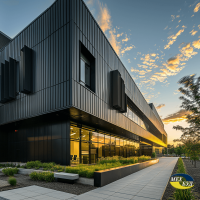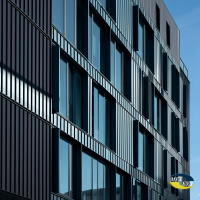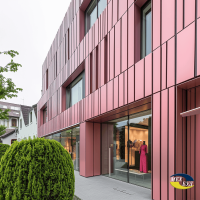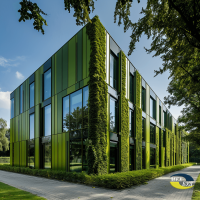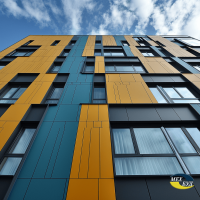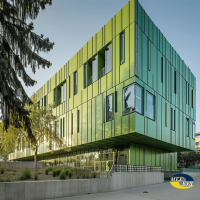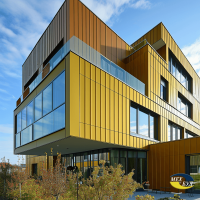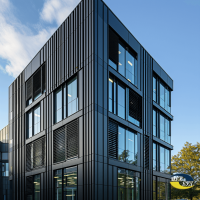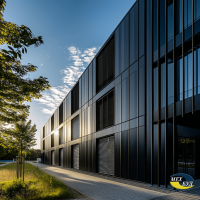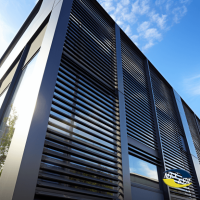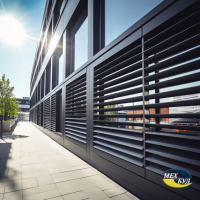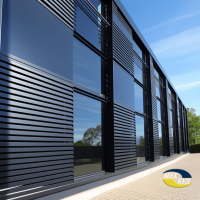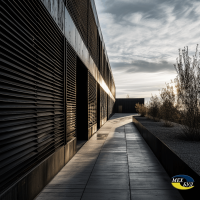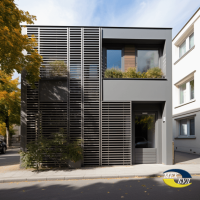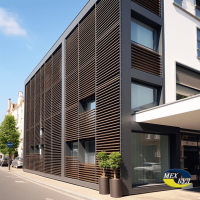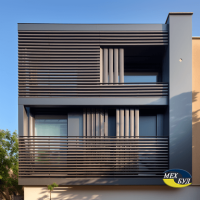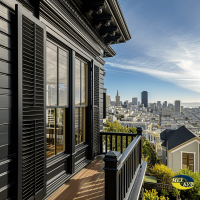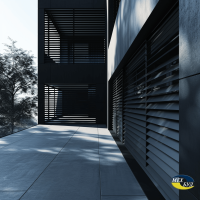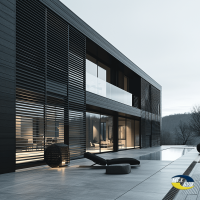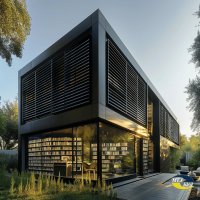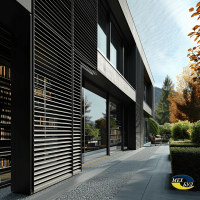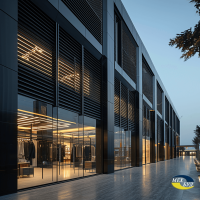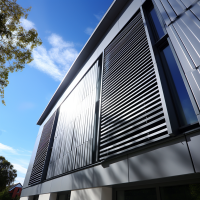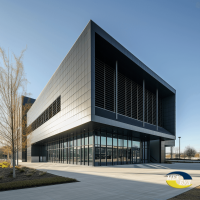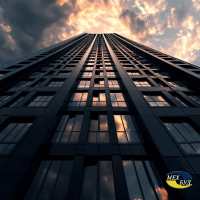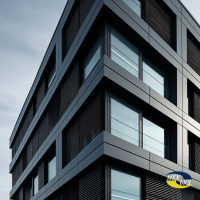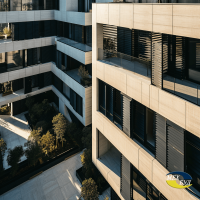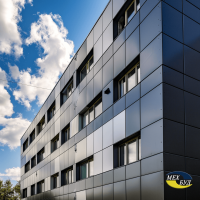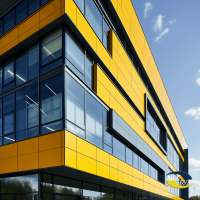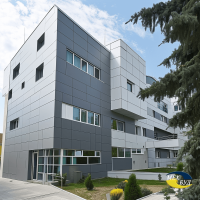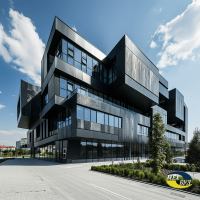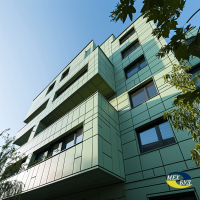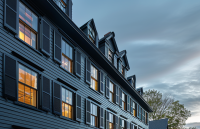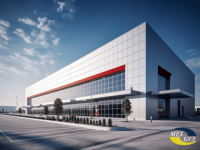The facades of commercial buildings in 2024
BRIEF OVERVIEW OF TRENDS AND INNOVATIONS IN 2024
In 2024, several key trends are shaping the selection and design of facades in commercial building architecture:
- Sustainability and Eco-Friendliness: Emphasis on using environmentally friendly and recycled materials, reducing energy consumption, and lowering CO2 emissions. Introduction of “green” facades with vertical gardens and photovoltaic elements.
- Technological Superiority: Application of innovative materials such as smart glass and composites that change properties in response to external conditions, along with the development of modular and parametric design.
- Individualization and Flexibility: Creation of a unique appearance through customized facade systems that can adapt to the specifics of the project and client preferences.
- Integration with Nature: Blurring the boundaries between internal and external spaces through transparent and semi-transparent elements, open areas, and landscape design.
- Digitization and Interactivity: Integration of digital technologies to create interactive facades capable of changing their visual information and interacting with visitors and the environment.
These trends reflect a commitment to creating not only beautiful and expressive buildings but also smart, energy-efficient, and harmoniously integrated structures into the surrounding environment.
LINEAR FACADES
Linear facades comprise a system that involves a sequence of parallel lines or panels, often utilized to create a dynamic and contemporary appearance for a building. These facades can be horizontal, vertical, or intersecting, depending on the architectural concept.
FEATURES:
- Geometric Play: Linear facades establish a clear and organized visual rhythm, introducing a sense of order and modernity to the building’s design.
- Light and Shadow: Properly positioned linear elements of the facade can effectively manage natural lighting, creating picturesque interplays of light and shadow.
- Ventilation and Visibility: Some linear facades can provide natural ventilation or partial transparency, preserving the privacy of internal spaces.
DESIGN AND ARCHITECTURAL POSSIBILITIES
Linear facades offer architects and designers endless opportunities for creativity. They can be used to emphasize or disrupt the strict lines of a building, add dynamism, or create a sense of scale.
- Modularity: Linear elements can be assembled in various configurations, allowing for the creation of unique and variable facades.
- Integration with Other Elements: Linear facades can be combined with other types of facade systems, such as glass or curtain wall systems, to develop more complex and interesting architectural solutions.
- Cultural and Contextual Interaction: Facades can be designed to reflect or complement their surrounding environment and cultural context, creating buildings that are both part of the urban landscape and outstanding architectural achievements.
MATERIALS AND INSTALLATION METHODS
Various materials are employed in creating linear facades, each offering unique properties and advantages.
Materials:
- Metals (aluminum, galvanized steel): Used to create thin, sturdy lines and available in various shades and coatings. An excellent choice for a durable facade material.
- Composite Materials: Combine the benefits of multiple materials, often providing enhanced characteristics and durability.
Installation Methods:
- Prefabrication: Many elements of linear facades can be prefabricated, expediting and simplifying on-site installation.
- Modularity and Adaptability: Systems are often designed to be modular and easily adaptable to different architectural conditions.
- Technological Innovations: The application of new technologies in fasteners and connections enables the creation of more intricate and delicate structures while ensuring reliability and safety.
Linear facades present a modern and stylish solution for commercial buildings, offering a unique blend of aesthetics, functionality, and innovation. Their application allows for the creation of impressive and memorable structures that become prominent focal points in urban architecture.
BLIND FACADES
Blind facades are systems that use movable or fixed slats to control light, heat, and airflow entering a building. They can be made from various materials, including metal, wood, or plastic, and are often installed on the external side of glass facades.
FUNCTIONALITY:
- Light and Heat Regulation: Blinds allow precise control over the amount of natural light and heat entering a space, contributing to creating a comfortable indoor climate and reducing costs for lighting and air conditioning.
- Ventilation: Adjustable blinds can provide natural ventilation, allowing fresh air to circulate within the building and improving air quality.
- Protection from Elements: Blinds protect interiors from strong sunlight, wind, and rain, and can also serve as an additional means of privacy.
DESIGN VERSATILITY AND CONTROL
Blind facades offer significant design flexibility, allowing architects and designers to choose from a variety of styles, colors, and materials.
- Adaptability: Blinds can be designed for automatic or manual control, adapting to changes in the external environment and user needs.
- Aesthetic Flexibility: Modern blinds offer a wide range of designs and finishes, enabling their integration into any architectural style, from classical to high-tech.
- Technological Integration: Integration with smart home and building systems allows for the creation of dynamic facades that respond to changes in weather, time of day, and other factors.
APPLICATION EXAMPLES AND EFFICIENCY
Blind facades are actively used in many modern buildings, from office centers to residential complexes, demonstrating their effectiveness in various climatic conditions.
- Office Buildings: Integrating blinds into office buildings helps create workspaces with comfortable lighting and temperature, reducing energy consumption for lighting and climate control.
- Residential Complexes: In residential buildings, blinds can provide additional privacy, sun protection, and temperature regulation, enhancing the comfort and safety of residents.
- Educational and Cultural Institutions: In schools, universities, and museums, blinds help maintain an optimal climate and lighting for preserving exhibits, visitor comfort, and student well-being.
Blind facades not only enhance the aesthetic appeal and functionality of buildings but also contribute to sustainability and energy efficiency, adapting to modern architecture and design requirements. These systems are becoming increasingly popular for their ability to significantly improve the quality of life and work inside buildings, as well as for their potential to create a unique and memorable look for any architectural project.
SOLUTIONS FROM THE “MEHBUD” FACTORY
The “Mehbud” factory is known for its innovative approaches in the field of facade systems, offering a wide range of products that meet modern requirements in architecture and construction. The factory’s main specialization lies in the manufacturing and installation of various types of facades, including curtain wall systems, linear facades, blinds, and other systems.
- Individual Solutions: “Mehbud” provides services for individual facade system design, enabling clients to bring their unique architectural concepts to life.
- Technological Equipment: The use of modern equipment and innovative technologies in production contributes to the enhancement of product quality and durability.
- Environmental Initiatives: The factory prioritizes environmental sustainability, employing materials with low environmental impact and increasing the energy efficiency of its products.
EXAMPLES OF COMPLETED PROJECTS AND THEIR FEATURES
“Mehbud” has a portfolio that showcases numerous successfully completed projects, each demonstrating an innovative approach and a commitment to excellence.
The facade with Classic blinds for the “Dobrobut” clinic in Kyiv
Rack facade for the logistics center in Poltava
Facade panels for Oxford Medical clinic in Kyiv
The linear facade in Kyiv has become the main decorative element for the Silpo store
TECHNICAL AND AESTHETIC ADVANTAGES OF THE PRODUCTS
The products from the “Mehbud” factory possess a range of significant advantages, making them a preferred choice for many architects and developers.
- Durability and Reliability: The use of high-quality materials and modern technologies ensures the longevity and resilience of facades to various external influences.
- Energy Efficiency: “Mehbud” facade systems are designed to minimize heat loss and optimize the use of natural light, contributing to the reduction of building energy consumption.
- Aesthetic Flexibility: The factory offers a wide variety of designs and color options, allowing for the creation of visually appealing facades that harmonize with the surrounding environment.
The products and solutions from the “Mehbud” factory reflect contemporary trends in architecture and construction, offering innovative, functional, and beautiful facade systems that enhance both the exterior and interior spaces of buildings.
CONCLUSION
Innovations in facade construction play a crucial role in the architecture of modern commercial buildings. They not only define the visual identity of structures but also contribute significantly to their resilience, energy efficiency, and functionality. Modern facade systems, such as curtain wall systems, linear facades, and blinds, represent complex engineering and architectural solutions that contribute to the creation of a healthy and comfortable living and working environment.
Innovations in facade construction will inevitably continue to influence the appearance and functionality of commercial buildings, making them more adaptable, resilient, and comfortable. They open new horizons for creativity and engineering, helping create buildings that not only impress with their exterior but also contribute to the establishment of a healthy and sustainable environment for future generations.

